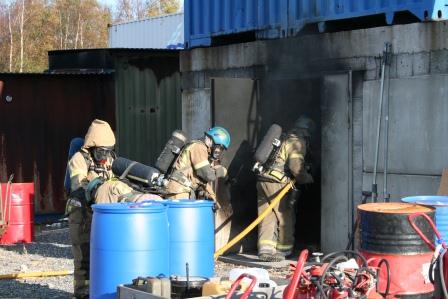
Photo: SINTEF/Astrid-Sofie Vardøy
A wireless sensor system created for medical rehabilitation has been shown to be useful in assessing health risks of "smoke divers," firefighters who have to enter burning buildings.
Researchers in Norway recently tested a U.S. Army-funded warning system called ESUMS that measures body movement and vital signs to help determine "heat stress" and other physiological dangers smoke divers face. "The equipment we used worked perfectly and the method correctly identified the risk situations that we simulated, so the trials showed that the method could be a useful way of determining whether or not a smoke-diver is in danger," project manager Trine Seeberg, a senior scientist at Norwegian research organization SINTEF, said in a press release.
Firefighters in a training facility at Rygge Airport in Norway wore chest belts to measure heart rate and skin temperature. The belt transmitted data via Bluetooth to each firefighter's smartphone. Accelerometers and gyroscopes also provide information on body position and activity level.
In consultation with smoke divers and in laboratory trials before the field test, SINTEF developed algorithms to quantify how the body responds to heat stress. A smartphone app runs the algorithms to determine a "hazard threshold score" on a 10-point scale, and the phone sends this score to a central monitoring station away from the fire.
"If the score is more than 8, the smoke-diver is being exposed to a high level of stress and should abandon the operation, while a score of 2 shows that the person is in good physical condition and is operating at a level of activity that is not hazardous to health," Seeberg said.
"These are important data, because smoke-divers are exposed to severe stresses," she explained. "They often operate under conditions of high temperature, wear insulating clothing, and have to carry equipment that can weigh as much as 15-20 kilos [33-44 pounds]. In practice, it is an extremely demanding task merely to be in a warm room with such clothing and with a pack on your back."
SINTEF researchers won a "pHealth" innovation award in 2010 at the International Conference on Wearable Micro and Nano Technologies for Personalized Health for its method of calculating risk. However, Seeberg says the measurement system needs more work, such as integration into firefighter safety gear, before it is ready for commercialization.
SINTEF originally worked with the U.S. Army's Telemedicine and Advanced Technology Research Center (TATRC) to develop the technology for home-based rehab of patients with congestive heart failure. The $3.6 million project produced the sensor belt, the smartphone app and desktop software for nurses connected to a server in a traditional healthcare setting.
















